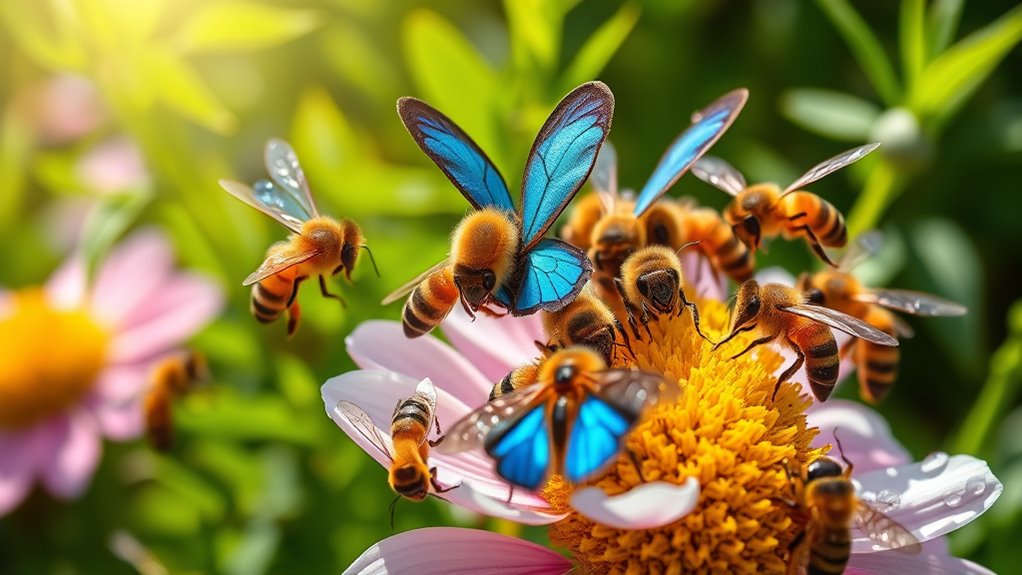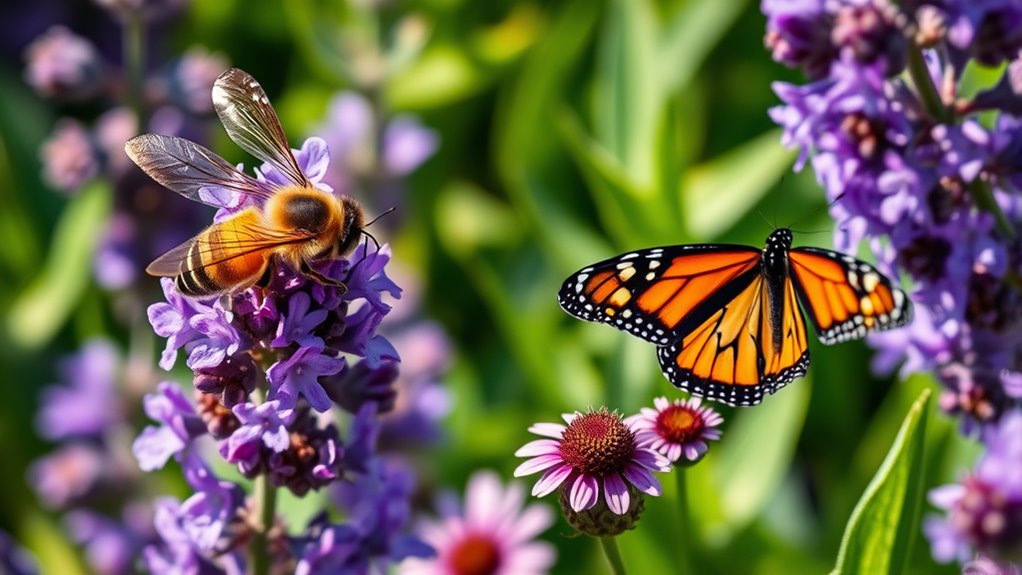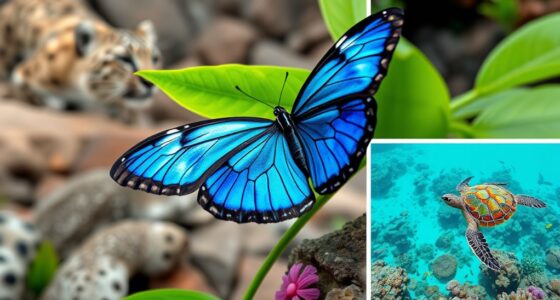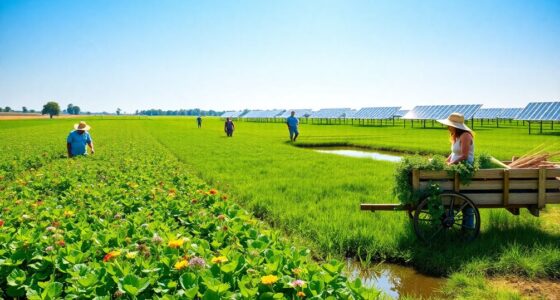Globally, efforts to protect pollinators focus on reducing pesticide use, especially harmful neonicotinoids, and creating safe habitats like urban gardens and pollinator corridors. Communities and policymakers encourage native plantings, organic practices, and habitat connectivity to support bees and butterflies. Education campaigns and grassroots initiatives foster awareness and action, while city policies promote pesticide-free environments. Staying engaged can help you learn how these combined efforts are essential for food security and ecosystem health.
Key Takeaways
- Global initiatives promote pesticide bans and regulation to reduce harm to bee and butterfly populations.
- International programs encourage habitat restoration through planting native, pesticide-free flowers worldwide.
- Governments and NGOs run awareness campaigns highlighting pollinator importance and conservation strategies.
- Policies support creating pollinator corridors and protected areas to connect habitats across regions.
- Collaborative efforts involve community engagement, research, and policy changes to ensure sustainable pollinator populations.

Have you ever wondered what would happen if pollinators disappeared? Without bees, butterflies, and other essential insects, many of the foods you enjoy—fruits, vegetables, nuts—would become scarce. This potential crisis has sparked global efforts to protect these essential creatures. One effective strategy revolves around creating urban gardens, which serve as critical habitats in city environments. By transforming vacant lots, rooftops, and backyard spaces into thriving gardens filled with native plants, you can provide food and shelter for pollinators. These gardens not only support local ecosystems but also help reconnect pollinators with natural resources fragmented by urban development. When you plant diverse, pesticide-free flowers, you reduce the risks posed by harmful chemicals that threaten pollinator health. Pesticide reduction is a fundamental part of these efforts because many pesticides, especially neonicotinoids, have been linked to declines in bee populations. Opting for organic gardening practices or using integrated pest management techniques minimizes chemical use, creating a safer environment for pollinators to forage and thrive. This conscious choice directly contributes to their survival, especially in urban areas where natural habitats are limited. Additionally, urban gardens foster community engagement and awareness. When you participate in local gardening initiatives or educate others about the importance of pesticide reduction, you’re helping to build a collective effort to safeguard pollinators. These gardens also serve as educational spaces where people can learn about native plants and the critical roles pollinators play in food production and biodiversity. Beyond individual actions, many cities are adopting policies to promote pesticide reduction and support pollinator-friendly practices. These include establishing pollinator corridors, incentivizing organic farming, and encouraging the planting of native species in public spaces. Your involvement can influence local policies, push for greener city planning, and inspire others to take action. Every small step counts—whether it’s planting a few native flowers in your yard, advocating for pesticide-free options in your community, or volunteering in urban garden projects. By doing so, you’re helping create a network of safe habitats that sustain pollinator populations. Ultimately, protecting pollinators requires a combination of individual choices and systemic change. Urban gardens and pesticide reduction are accessible ways to make a meaningful difference—turning concrete jungles into vibrant ecosystems where bees and butterflies can flourish. If more people take these steps, we can ensure that future generations will continue to enjoy the bountiful harvests and natural beauty that pollinators support. Your proactive involvement is essential; it’s about creating healthier environments for pollinators and, by extension, for humanity itself. Recognizing the importance of AI safety measures and ongoing research can further enhance our efforts to protect these vital species.
Frequently Asked Questions
How Do Urban Areas Impact Pollinator Populations?
Urban areas impact pollinator populations by creating urban challenges like habitat fragmentation, which reduces the available space for bees and butterflies to thrive. You might notice fewer flowering plants and nesting sites, making it harder for pollinators to find food and shelter. These challenges lead to declining pollinator numbers, yet by planting native flowers and creating green spaces, you can help support their populations amidst city environments.
What Are the Most Effective Ways for Individuals to Help Pollinators?
You can help pollinators by planting native species in your yard or community gardens, providing essential nectar and habitat. Avoid pesticides, which harm bees and butterflies. Support local conservation efforts and advocate for pollinator-friendly policies. Additionally, creating pollinator corridors and planting diverse flowers throughout the seasons guarantees food sources year-round. Your actions make a difference in sustaining healthy pollinator populations and supporting global conservation efforts.
Are Certain Plant Species Better for Supporting Pollinators?
Imagine your garden as a buzzing oasis—certain plants can turn it into a pollinator paradise. Native plants and flowering trees are like a feast for bees and butterflies, offering familiar nectar and pollen. These species are better because they’ve evolved alongside local pollinators, making them more effective. By planting native and flowering trees, you create a vibrant, supportive habitat, helping pollinators thrive and ensuring your garden blooms beautifully.
How Do Pesticides Specifically Harm Bees and Butterflies?
Pesticides harm bees and butterflies mainly through chemical exposure, which can disrupt their nervous systems, impair their ability to forage, and reduce their lifespan. Additionally, pesticides contribute to habitat loss by killing native plants they rely on for food and shelter. When you use chemicals indiscriminately, you not only threaten pollinator health but also diminish the ecosystems they support, making it vital to adopt bee-friendly practices.
What Are the Economic Benefits of Protecting Pollinators Globally?
By safeguarding pollinators, you boost pollination economics, which directly enhances crop yield benefits worldwide. Healthy bees and butterflies ensure better fruit, vegetable, and seed production, increasing farmers’ income and reducing food prices. This stability supports local economies and global markets alike. Investing in pollinator conservation helps secure food supply chains, creates jobs, and promotes sustainable agriculture, making it a smart economic choice for future prosperity.
Conclusion
By taking action now, you can help protect pollinators like bees and butterflies. Imagine a world where 75% of our crops depend on these tiny workers—without them, our food supply faces collapse. Every small effort, from planting native flowers to avoiding pesticides, counts. Together, we can guarantee future generations enjoy vibrant gardens and bountiful harvests, safeguarding these essential pollinators. Your involvement makes a difference—start today for a healthier, more balanced planet.








